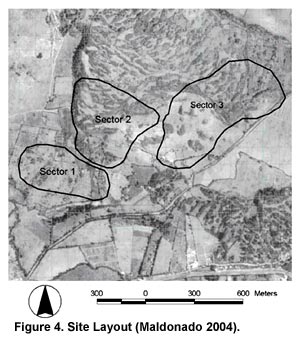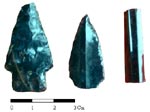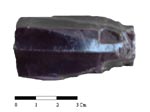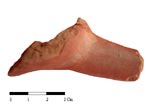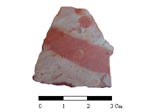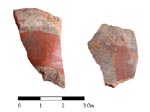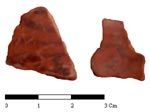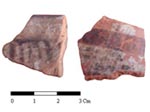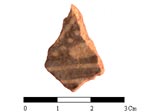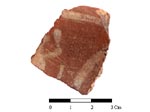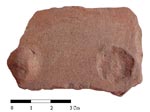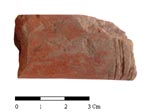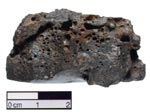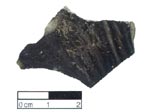
| FAMSI © 2005: Blanca E. Maldonado |
||||||||||||||||||||||||||
|
Tarascan Copper Metallurgy at the Site of Itziparátzico, Michoacán, México Fieldwork With the support of FAMSI and the Pennsylvania State University, I initiated systematic archaeological investigations at Itziparátzico during the summer of 2003. The surveyed area covered the zones explored by Cárdenas, and their surroundings and beyond. Intensive surface survey was used to locate production areas represented by concentrations of manufacturing by-products (i.e. slag). GIS equipment was employed to map an area of approximately 15 sq km and record archaeological materials and features. Three major sectors of the site were identified and mapped during this survey (Figure 4). Archaeological materials are present at varying densities throughout the whole site. A total of 79 surface collections were made during the survey that included ceramics, lithics (mainly obsidian), and slag. These materials were sorted and quantified, and still remain to be further analyzed. Slag concentrations were located almost exclusively around three freshwater springs, all of them situated toward the center of the surveyed area (Sector 1, Figure 4). Both the presence of smelting by-products and the proximity to water (indispensable for metalworking processes) indicate that smelting activities may have taken place at this sector of the site. Other materials collected from this sector include moderate amounts of potsherds and lithics (mainly obsidian prismatic blades). Among the most remarkable materials recollected during the survey is a set of stylistically diverse Tarascan pipes, which were also collected from Sector 1. Helen Pollard has positively identified these pipes and several polychrome ceramic fragments as Late Postclassic (for examples, see Figure 11, Figure 12, Figure 13, Figure 14, Figure 15, Figure 16, Figure 19, and Figure 20; thumbnail images shown in Table 1 below). The combination of ceramic pipe fragments, Tarascan polychrome ceramics, and prismatic blade fragments (probably from Ucareo) at the site, indicates an elite occupation (Pollard 2003; Pollard et al. 2001). The second sector of the site (Sector 2, Figure 4) consists basically of terraces, both occupational and agricultural. A total of twenty-seven terraces, most of them domestic in nature, were identified in this sector of the site. Although some slag is scattered on surface, the amounts are significantly smaller than those at Sector 1. Sector 2 presents, on the other hand, the highest densities of potsherds and lithics on surface. Some of these potsherds present painted decoration. Lithics include obsidian blades and a few grinding stone fragments. Two anthropomorphic figurine fragments were also collected from one of the terraces. The third sector of the site (Sector 3, Figure 4) contains numerous mounds, as well as presence of lithic and ceramic materials on surface. A total of thirty-one earthen mounds were recorded throughout the survey area; about a third of them are in Sector 3. The patchiness of the materials on surface suggests a scattered settlement pattern and a relatively short-lived Prehispanic occupation, presumably, affiliated with the Late Postclassic Period. The results of this surface survey have set the parameters for the selection of excavation areas. Sample collection from stratigraphic context was the next critical step of my research. I conducted nine weeks of intensive fieldwork beginning in mid January and ending in late March 2004. This fieldwork involved the preliminary archaeological test excavations in the three major sectors of the mapped area of the site: the sector of the water springs, which presumably represents the production zone of the site; the sector of the domestic terraces; the sector of the large mounds (see Figure 4). Seven test-pits were excavated through deposits of silt and clay in different parts of the area. The overall aim was to assess the quality and significance of the archaeological information obtained during the surface survey. Three of these test pits were located in Sector 1, two in Sector 2, and two more in Sector 3. All metallurgical remains, pottery, lithics, soil samples, and soil and radiocarbon samples were collected. The results of these excavations were consistent with the observations on surface. No consistent evidence for occupation before the Late Postclassic Period was found.
Although their actual processing is still in progress, all of the ceramic and lithic artifacts from excavation seem consistent with a Late Postclassic Tarascan occupation. The lithics include obsidian blades, arrow heads, modified flakes, and cores (Figure 5, Figure 6). Basalt blades, axes and hammers were also recovered, as well as grinding stones (Figure 7, Figure 8). Discreet amounts of potsherds were recovered including both undecorated and decorated samples. The most abundant fragments correspond to a domestic, well-polished, red-slipped ware (Figure 9). Although the general condition of the pottery is highly fragmentary, in this case, we have been able to identify pieces of jars and bowls, as well as two fragments of stirrup-spouts (see Figure 10). The most common type among the decorated specimens is a red-and-white-on-orange ware, which seem to have included forms such as bowls and plates (Figure 11, Figure 12). Other polychrome examples in our collection are shown in Figure 13, Figure 14, Figure 15, and Figure 16. Incised and appliqué decoration is also represented in the sample (Figure 17 and Figure 18). The ceramic assemblage also includes a number of Tarascan pipe fragments (Figure 19, Figure 20). Regrettably, no identifiable metalworking structures (furnaces, hearths, and pits) were found at Itziparátzico during the test-pitting. Slag samples recovered from excavation, therefore, represent the most relevant material for the purposes of this project. While these smelting waste-products were recovered in large amounts, only a representative sample of 2.1 kg was selected and exported for metallographic analysis. Part of this material is currently being analyzed at the Institute of Archaeology, University College London (see Figure 21 and Figure 22 for examples of slag specimens). The absence of metallurgical materials other than slag (i.e. fuel, hearth structures, crucible fragments, mould fragments, stock metal, metal prills, failed castings, part-manufactured objects and spillages, etc.) around Itziparátzico is remarkable, although it may indicate that only primary copper production was being carried out at the site. Primary production involves the actual smelting or extraction of metal from its ore by heating. Conversely, secondary production or smithing implies the working or forging of metals into artifacts (Bachmann 1982). |
||||||||||||||||||||||||||
|
Text links to all pages at this site are available at the FAMSI INDEX |
||||||||||||||||||||||||||
